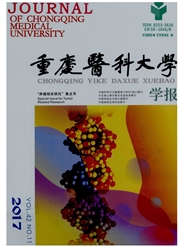

 中文摘要:
中文摘要:
目的:通过光镜和电镜观察并探讨慢性脑血流灌注不足大鼠海马的组织病理学和超微结构的动态变化。方法:将60只SD大鼠随机分为模型组和假手术组,其中模型组50只,假手术组10只。模型组采用永久性双侧颈总动脉结扎术方法建立血管性痴呆大鼠模型后,再随机分为术后1、7、14、21 d组和28 d组,每组10只;假手术组麻醉后只分离双侧颈总动脉而不结扎。不同时间点断颈处死大鼠,取大脑,切片,分别在光镜和电镜下观察海马神经元的动态变化。结果:与假手术组相比,各模型组大鼠海马CA1区神经元数量均显著减少(P=0.000),其中术后14 d组海马CA1区神经元最少,超微结构显示神经元变性,核固缩,而后随着脑血流的恢复,海马神经元数量逐渐增加,神经元损伤有所改善。结论:在慢性脑血流灌注不足早期,海马神经元损伤是可逆的,为临床对慢性脑血流灌注不足患者进行早期治疗以预防血管性痴呆提供理论依据。
 英文摘要:
英文摘要:
Objective:To study the histopathological and ultrastructural changes in the hippocampus of rats with vascular dementia (VD) by light and electron microscopy. Methods:Totally 60 SD rats were randomly divided into sham-operated group (n=10) and model group(n=50). VD models were constructed by permanent bilateral common carotid artery ligation and 10 rats were killed at each time point( 1,7,14,21,28 d) after operation (1,7,14,21,28 d model groups). Rats in sham-operated group were only separated, not ligated bilateral common carotid arteries. Histopathologieal and ultrastructural changes in the hippocampus were observed with microscopy and electron microscopy respectively at each time point with 10 killed VD rats. Results:Numbers of neurons in CA1 region of rats' hippocampus in model group were decreased significantly compared with those in sham-operated group, being the fewest in 14 d model group(P=0.000). Ultrastructural changes demonstrated the pyknosis and degeneration of neurons, however, with the recovery of cerebral blood flow supply,numbers of neurons were gradually increased and less neuron degeneration was observed with electron microscopy. Conclusions : At early stage of chronic cerebral hypoperfusion, degereration of neurons in the hippocampus is reversible,which provides theoretic basis for early clinical treatment of chronic cerebral hypoperfusion in prevention of VD.
 同期刊论文项目
同期刊论文项目
 同项目期刊论文
同项目期刊论文
 期刊信息
期刊信息
